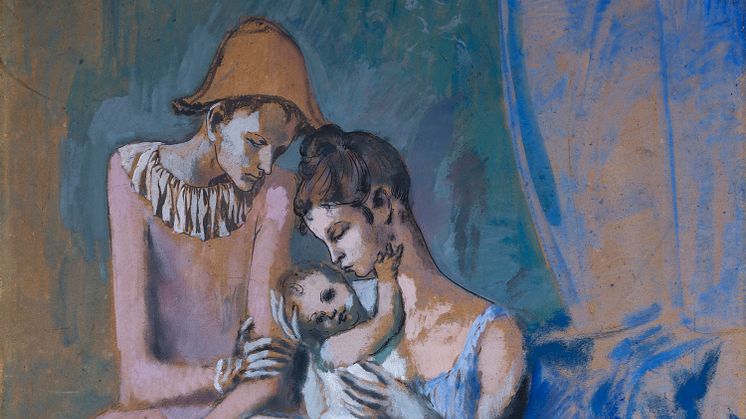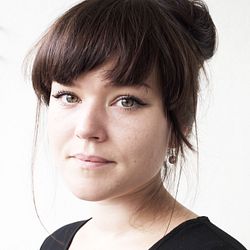
Pressmeddelande -
Iconic work by Picasso returns to Gothenburg
Pablo Picasso’s Acrobat Family is back in Gothenburg after having been seen by close to a million visitors in Paris and Basel. The work is now shown in a new presentation at the Gothenburg Museum of Art, opening on 26 October when the museum invites the public to a lecture day with the world-leading Picasso expert Dr. Marilyn McCully.
“We wish to highlight the fact that this unique work belongs to our collection and the responsibility that this involves. It has an exciting history that involves some of the major proponents of avant-garde art at the beginning of the 20th century, namely Leo and Gertrude Stein. We hope that our visitors are just as proud as we are that the work is part of our collection and take the opportunity to learn more about how it came to Gothenburg”, says Anna Hyltze, Acting Director of the Gothenburg Museum of Art.
The work owned by the Gothenburg Museum of Art, Acrobat Family, belongs to Picasso’s rose period, during which the artist depicted acrobats in the world of the circus, often behind the scenes and not seldom with an undertone of melancholy. The work is one of the museum’s most famous and sought-after works, but despite this fact it has only been on loan around fifteen times. Over the past year, Acrobat Family has been displayed at the Musée D’Orsay, Paris, and Fondation Beyler, Basel, in one of the most comprehensive exhibitions about Picasso’s blue and rose periods.
Discovery of a sketch during conservation
In conjunction with the loan, a thorough assessment of the work’s condition was carried out, which resulted in a major conservation project. In collaboration with international research teams such as CATS (Centre for Art Technological Studies and Conservation) and MOLAB (Mobile LABoratory), the work continues to better understand the materials and technique of the work and thereby find the best solution for conserving the painting.
During the conservation project, a sketch was discovered on the reverse side of the painting.
“We do not have a lot of information about the sketch at present, but it is cause for further research and in-depth studies. We know that Picasso reused forms and figures in his compositions, and the sketch can perhaps be related to another work from this time”, recounts Mariateresa Pullano, conservator for works on paper at the Gothenburg Museum of Art.
Delving deeper into the history and future of the work
To celebrate the fact that the work is back at the Gothenburg Museum of Art, Acrobat Family is now shown in a presentation that recounts the exciting story of the painting’s history and the museum’s important work in preserving the cultural heritage for future generations.
“We have had the opportunity to delve deeper into the work, regarding both the previous owners and the condition of the work, but also in relation to other works by Picasso in the collection”, says Eva Nygårds, curator at the Gothenburg Museum of Art.
In-depth information is presented in three films that are shown in A Close Study of Acrobat Family – Perspectives on Picasso. In conjunction with the opening of the presentation, the Gothenburg Museum of Art invites the public to a lecture day on 26 October, with a key-note lecture by the world-leading Picasso expert Dr. Marilyn McCully, curator and author.
The lecture program is presented below.
Press preview
Welcome to the press preview on Thursday 24 October 11.00.
Acting Museum Director Anna Hyltze welcomes everyone. Curator Eva Nygårds and Paper Conservator Mariateresa Pullano show the presentation.
Sign up for the press preview via e-mail to eva.rosengren@kultur.goteborg.se before Tuesday 22 October.
Contact
Eva Rosengren, Press Liaison
+46 31 368 35 93
eva.rosengren@kultur.goteborg.se
Eva Nygårds, Curator
+46 31 368 35 03
eva.nygards@kultur.goteborg.se
Mariateresa Pullano, Conservator for works on paper
+46 31 368 35 23
mariateresa.pullano@kultur.goteborg.se
Anna Hyltze, Acting museum director
+46 31 368 35 20
anna.hyltze@kultur.goteborg.se
PROGRAM 26 October 1pm – 3pm
Note that all lectures are in English.
Dr. Marilyn McCully, Art historian, curator, author
The harlequins go in splendid rags
With an exhibition planned for February 1905 at the Galeries Serrurier in Paris, Picasso embarked on a new body of work that he hoped would not only result in sales but would enhance his reputation in the French capital. The majority of works in the exhibition would feature a new theme, focusing on the lives of saltimbanques – itinerant acrobats and performers, often in Harlequin’s costume. In addition, he experimented with different materials and techniques, ranging from gouache on cardboard to prints. Acrobat Family will be discussedin the context of a number of saltimbanque compositions.
Eva Nygårds, curator at the Gothenburg Museum of Art
From the salons of the Stein family in Paris to the Gothenburg Museum of Art – The provenance of the Acrobat Family
Acrobat Family was once owned by the art collectors and siblings Leo and Gertrude Stein, whose home in Paris was an important meeting point for artists and intellectuals. While some of the details regarding provenance are still to be revealed, we know that the work came to Sweden through the Norwegian art dealer Walther Halvorsen, and finally to Gothenburg thanks to the art collector Conrad Pinéus. The lecture discusses questions about the history of the work and how this iconic painting became a part of the collection at the Gothenburg Museum of Art.
Mariateresa Pullano, conservator for works on paper at the Gothenburg Museum of Art
Dr. David Buti, conservation scientist, CATS Centre for Art Technological Studies and Conservation, Denmark
Picasso’s Acrobat Family in focus: an investigation of materials and techniques
The scientific investigations carried out on Acrobat Family have cleared up some of the uncertainties regarding the painting technique employed by Picasso in this work as well as shedding light on its conservation condition.
The light fastness of blue pigments and the fragile condition of the cardboard’s support have also been underlined as issues to be considered in the preservation of the object. To better understand the material, technique and condition of the painting, a scientific examination was undertaken in collaboration with CATS and MOLAB, from the IPERION European Research Project, to study the fading of the blue paints, the nature of the water and oil-based media and the condition of the support.
Mariateresa Pullano and Dr. David Buti share their expertise and new findings.
Ämnen
Regioner
Göteborgs konstmuseum har en av norra Europas främsta konstsamlingar. Denna sträcker sig från 1400-talet fram till idag med betydande verk inom både nordisk och internationell konst. Förutom samlingen erbjuder museet utställningar, familjeaktiviteter, föreläsningar, workshops och visningar. Här finns restaurang samt en välsorterad museibutik. Samlingen omfattar omkring 70 000 verk och museet har ca 250 000 besökare årligen.

